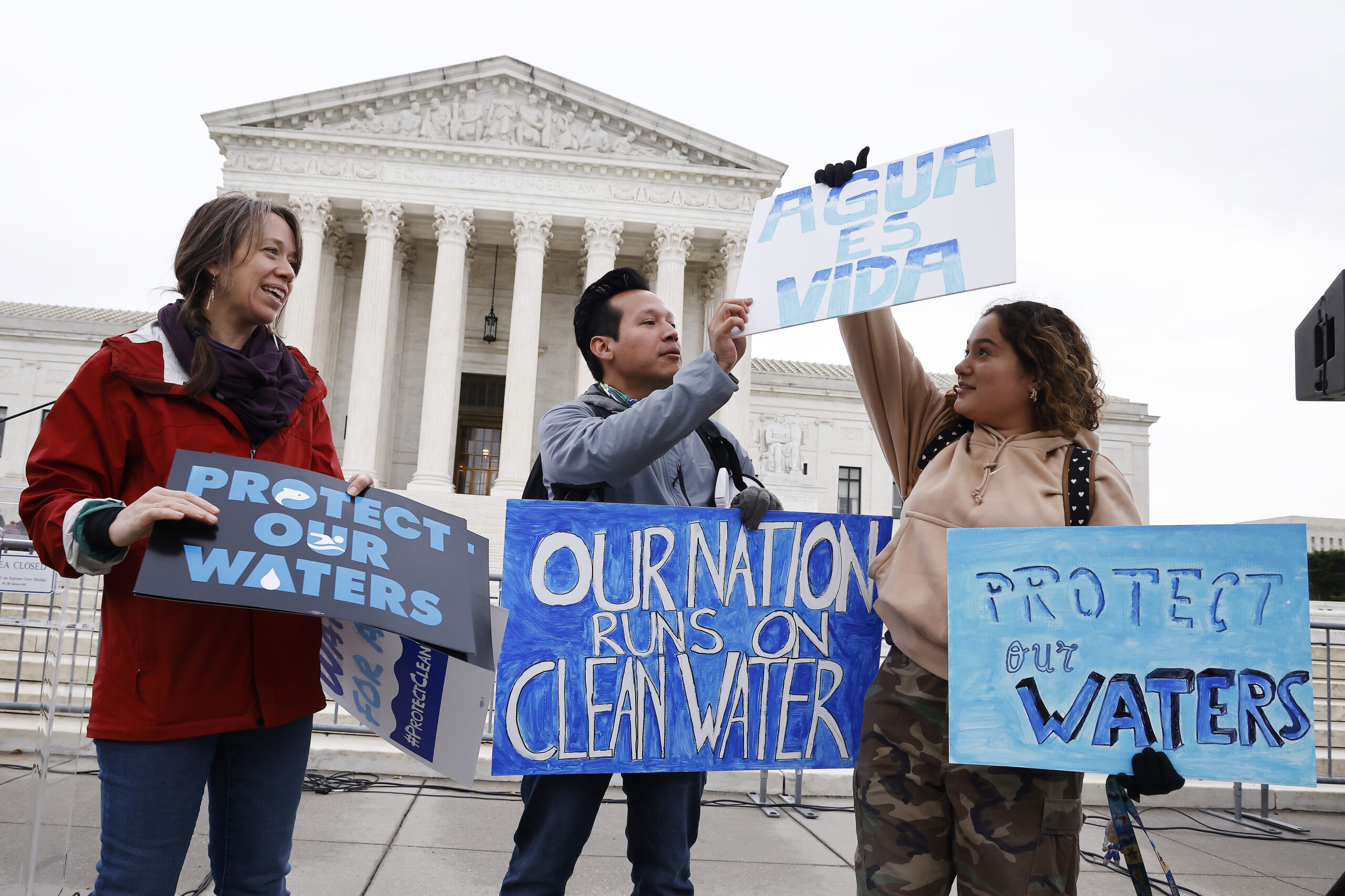In the best political development in recent memory, a pod of orcas off the coast of Spain have been attacking yachts and sinking them. Witnesses describe the attacks as methodical and organized: the orcas shake and even detach rudders from the boats, while other members of the group ram the vessels with their bodies. Experts suspect that their matriarch, White Gladis, may have suffered a traumatic incident with a boat in the past and has been enacting a campaign of vengeance ever since. Let me posit another possible trigger for Gladis’ radicalization and commitment to take up combat against humanity: she heard about the 2008 United States Supreme Court decision in Exxon Shipping Company v Baker.
The Exxon Shipping case is the final chapter in a nearly twenty-year litigation saga following the catastrophic Exxon Valdez oil spill in Alaska’s Prince William Sound in March 1989. Though a jury decided that Exxon Mobil–the third largest corporation in America in 1989–had to pay $5 billion in punitive damages for its role in the environmental disaster, the Supreme Court reduced the figure to just ten percent of the original amount, saying that the damages amount , which had already been reduced by a federal judge, was “excessive” and “unfair.”
What was excessive was Exxon Mobil’s corporate disregard, which led to the oil spill. What was unfair was the monumental damage to wildlife and local economies along 1,300 miles of Alaska coastline affected by the spill. A rundown of the facts: after an inebriated captain left an overworked and unqualified third mate to navigate the rocky and iceberg-filled Prince William Sound alone, the supertanker Exxon Valdez ran aground just after midnight on March 24, 1989. The ship was carrying 53 million gallons of crude oil. Exxon reportedly had failed to maintain the radar system aboard, and a 1990 report on the accident by the National Transportation Safety Board found that layers of corporate malfeasance contributed to the unprecedented disaster: inadequate equipment, inadequate training of crew members, insufficient crew, a failure to provide effective pilotage services, and deficient oversight. Eleven million gallons of oil flowed into the sound.
The resulting environmental loss was, in a word, incomprehensible. Anyone of TV-watching-age in the nineties remembers the images: birds and other wildlife covered in oil, sickening black iridescence on the surface of vast expanses of seawater, cleanup crews digging up and wading through and hosing down masses of poisonous goop. In the days after the accident, an estimated 250,000 seabirds died, as well as nearly 3,000 otters, and hundreds of seals and bald eagles. Clean-up and containment efforts were delayed, bungled, and woefully inadequate. Scientists report that fresh oil can still be found along the Alaska coastline today. A pod of genetically unique orcas living in the area is expected to go extinct in the coming years–they haven’t had a calf since the year of the spill, and today there are only seven members left. This is to say nothing of the estimated billions of dollars in losses to fisheries, recreational sports, and tourism industries in Alaska, as well as the massive degradation impact on lands where indigenous people live and subsist. White Gladis is right. We deserve it.
Numerous legal actions were taken against Exxon Mobil after the spill, but the matter before the Court in 2008 involved one class of plaintiffs who sought punitive damages. Compensatory damages in the case–that is, money awarded in order to compensate plaintiffs for losses or injuries suffered by the corporation’s actions–amounted to just over $500 million. But unlike compensatory damages, punitive damages are not calculated in order to directly remunerate an injured party for a specific, proven amount of harm; instead, punitive damages are awarded to punish the defendant, and deter them from acting the same way in the future. After hearing extensive evidence about the harm caused by the spill, and Exxon management’s acts and omissions relevant to the spill, the jury was instructed “to consider the reprehensibility of the defendants’ conduct, their financial condition, the magnitude of the harm, and any mitigating facts.” In so doing, the jury awarded $5,000 in punitive damages against the captain of the Exxon Valdez, and $5 billion against Exxon.
Lucky for poor little Exxon Mobil, the Supreme Court was ready to step in to save the company from meaningful accountability. Over the course of the litigation process, the punitive damages against Exxon had already been reduced by an appellate court to $2.5 billion, but the Supreme Court’s holding went even further. In a 5-3 opinion (Justice Samuel Alito recused from the case because he owned between $150,000 and $200,000 in Exxon stock) written by Justice David Souter, the Court concluded that in maritime cases, “a numerical 1:1 ratio [of compensatory to punitive damages] is a fair upper limit”–meaning punitive damages could no longer exceed compensatory damages. Since compensatory damages against Exxon had amounted to $500 million, the company could not be ordered to pay more than that as punishment. No calculator needed–the holding meant that Exxon could only be punished one tenth of the amount that the jury originally ordered.
Shockingly, details of the environmental and economic havoc wrought by the Exxon Valdez oil spill are nowhere to be found in Souter’s opinion. After failing to consider or even mention any possible reason for the jury’s assessment of $5 billion in punitive damages, Souter drones at length about the history and purpose of punitive damages in the law. There is a reference to the Code of Hammurabi. There is a quote by someone named Lord Chief Justice Pratt in England in 1763. I’m sleeping, I’m snoring, I’m in full REM–but the thought of White Gladis whale sprinting towards a ship flanked by her comrades zaps me awake. We soldier on. Souter agrees that punitive damages are aimed at retribution and deterring harmful conduct. Okay, yes, I’m with you, bud! Next he references studies demonstrating an overall trend of reasonableness when punitive damages are awarded: “the discretion to award punitive damages has not mass-produced runaway awards…Nor do the data substantiate a marked increase in the percentage of cases with punitive awards over the past several decades.” Great! David, can I ask why we are here? This is the longest version of a solution in search of a problem I’ve ever had the displeasure of reading.

Finally, the dog catches its tail. Souter identifies the problem with punitive damages that necessitates letting Exxon go with a slap on the wrist for causing a catastrophe so profound that Republican President George HW Bush signed anti-pollution legislation into law the next year. The problem is a lack of predictability, apparently. Punitive damages awards vary in size, he says, and corporate bad actors are often unable to tell–at the outset of their misdeeds–the level of punishment they will be subject to beyond compensating their victims. “[A] penalty should be reasonably predictable in its severity,” so that corporations that cause harm “can look ahead with some ability to know what the stakes are in choosing one course of action or another.”
A glaringly obvious oversight of this analysis is that the unpredictability of punitive damages awards in cases of egregious corporate wrongdoing is a feature, not a bug, of our legal accountability mechanisms. What the majority opinion fails to contend with in setting this arbitrary damages cap is that in making punitive damages calculations “predictable,” and limited by the 1:1 ratio to compensatory damages, you allow a massive corporation like Exxon to calculate their overall liability ahead of time, and convert it into a budget line item. (Day one Exxon intern assignment: run a cost-benefit analysis of dropping a gallon of gasoline on this endangered mollusk.) In turn, the corporation is disincentivized from investing in safety, internal oversight, and protocol designed to avert disaster, because they can more accurately predict, far in advance, the ultimate cost of litigation that results from their bad acts. Contrary to the deterrent purpose of punitive damages, the holding in Exxon Shipping turns punitive damages into a foreseeable cost of doing business, essentially allowing companies to opt in to harmful behavior if, at the end of the day, the profits will exceed the costs.
In fact, we can do some quick calculations here ourselves. Justice Souter characterizes the punitive damages award against Exxon Mobil as “eccentrically high,” but offers no reason why other than it is ten times the compensatory damages award. For reference, the company’s sales in 2007 topped $400 billion. That was more than the GDP of 120 countries. In 2008, the year of this ruling, Exxon Mobil reported profits of $45.2 billion, the highest ever reported for an American company. Two and a half billion dollars would have comprised about 5% of Exxon’s profits at the time. Look at pictures of Prince William Sound in late March 1989 and tell me if you think giving up 5% of their profits in one year as punishment is excessive. Last year, the company’s profits exceeded $55 billion–also an all-time record among Western oil companies. That’s more than $100,000 in profit every single minute of the year. This shit is satanic bro I don’t even know what to say.
Beyond completely fumbling the deterrent effect of punitive damages, Justice Souter’s opinion boiling it all down to a question of simple arithmetic also subverts a foundational recognition in giving juries and judges discretion when awarding punitive damages: sometimes, damages are hard to quantify and hard to prove, but in cases of egregious harm by a corporate megalodon, the fair and just thing is for damages to be paid nonetheless. It also demonstrates how the Supreme Court will reign in the retributive and deterrent purposes of civil damages when powerful capital is being punished–while the same Court’s jurisprudence validating extreme punishment for poor criminal defendants seemingly knows no bounds.
Proportionately higher punitive damages awards can be reserved for outlier cases, and are subject to limitation by judicial review (as evidenced by the appellate court proceedings in this case, which had already reduced the damages award by 50%). Compensatory damages already cover what can be proven and calculated–a fisherman’s lost wages, a recreational boating business’ damaged equipment, perhaps even a Native American community’s loss of access to their hunting grounds for a season. But the Court’s ruling in Exxon Shipping mandates a math equation where the loss caused by Exxon is incalculable, and a quick doubling of the compensatory damages award doesn’t right the wrong. What’s the monetary value of a wild sea otter’s life? What about 22 orca whales? Or the experience of looking out at pristine wilderness as you walk along the rocks on a remote Alaska beach–is that quantifiable? Put a dollar number on Exxon’s desecration and disrespect for tribal lands and waters. Is that possible? I think the clear answer is no, but the power of a community to assess the collective harm done–and to what extent a corporate bad actor has to pay for it–is worth protecting in the law. Instead, the Supreme Court brushed untold human, animal, and environmental suffering under the rug, on behalf of one of the largest and most powerful corporations on the planet.
Oh and if you’re reading this and you know an Exxon exec who will be yachting off the coast of Spain any time soon, let me know. I have an orca we should contact.




